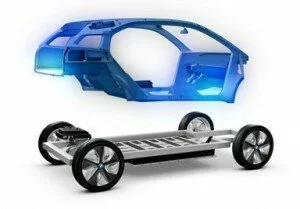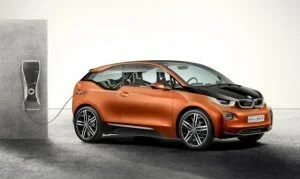Regular readers know it had been a life-long dream of mine to live in a solar house and also a life-long dream to drive a solar-powered car. I got the roof done. Cars with enough solar panels on their roofs to power themselves will almost certainly never be be practical in my lifetime, nor probably that of my kids. But stationary residential solar arrays already generate more than enough power for transportation use. As I outlined in my post 365 Sunrises, my residential solar array makes about 1,350 kWh in excess of what we need to power our house for a year. Could that be enough to power all my personal transportation needs?
What’s Up With Electric Cars?
The electric car has been “just around the corner” for a least a few decades. Propulsion efficiency and battery storage technology have always been the stumbling blocks. But in the last few years things have suddenly changed. Hybrid electric cars have gone from the drawing board to the mainstream, bringing with them a lot of learning and experience with electric motor and battery technology for cars. And now plug-in hybrids are in the process of supplanting those ordinary hybrids. By leveraging more powerful batteries to provide electric propulsion more of the time, plug-in hybrids nearly double the already good gas milage of a normal hybrid – plug ins will do 95 mpg or more for typical drivers.
Fully electric cars have been slower to catch on, however. But in the last two years, they have been starting to make some, um, headway. Nissan has had some success with its Leaf, though at 50-80 miles, real-world range has been a huge disappointment for early buyers. Tesla has made a splash with some spectacularly capable electric sports/luxury Model S, but at about $100,000 for a nicely equipped model, they have been stuck squarely above the mainstream price range. With both these cars, the critical issue is weight.
It’s the Weight, Stupid
Using traditional methods of car building (steel unibody design), and typical thinking about power train and passenger space layout, you end up with an electric car that is very heavy – too heavy to work well on its electric propulsion. Such a heavy car means a bigger motor, and a bigger motor means more expensive batteries, etc. Tesla stepped up to the plate in terms of batteries, which is why their car is expensive (no surprise, with 6,831 lithium ion cells storing about 53 kWh and weighing in at a mind-boggling 922 lbs). Nissan, on the other hand, didn’t step up on the battery front, so their less heavy and less expensive car simply doesn’t go very far.
And that stalemate is about where things have stood. We are making incremental improvements, but no one has made a real break-through. Until now, that is.
Salvation At Last
Late next year BMW is scheduled In April of this year BMW will release in the US a radical new car, the i3, which is designed and optimized from the ground up to be fully electric. Rather than using folded steel, BMW will be making the body shell out of carbon fiber. And rather than mounting the motor, battery and suspension in large bulky blocks bolted to heavy subframes, the motor is integrated with the rear axle and the batteries are spread in a thin layer throughout the entire floor of the car.  The result is a lower center of gravity, a much better use of space, a much lighter car, much better performance and efficiency than a typical car, and, because the batteries and power train can be smaller, the car will be reasonably priced, despite its exotic construction materials. (The i3 will be priced between BMW’s 3 series and 5 series cars.)
The result is a lower center of gravity, a much better use of space, a much lighter car, much better performance and efficiency than a typical car, and, because the batteries and power train can be smaller, the car will be reasonably priced, despite its exotic construction materials. (The i3 will be priced between BMW’s 3 series and 5 series cars.)
It Boils Down to Physics
At the heart of this brilliant design is a basic law of physics. The more a car weighs, the more energy it takes to accelerate it and stop it. The more energy it takes to accelerate it, the more the engine has to weigh to produce the power, and the more the car must weigh to carry that engine. The heaver the car is, the more the brakes and suspension have to weigh, and so on. This downward spiral continues until you have today’s status quo: an average car weighing in at about 4100 lbs and requiring about 200 horsepower to get around, while consuming a full gallon of fuel every 22 miles or so.
But if you can figure out a way to get that physics spiral to rotate in the opposite direction, it is just as powerful in reverse. Less weight requires less power, less power requires less motor and battery, less motor and battery require less suspension and brakes. Even smaller tires can generate fantastic handling when strapped to a lighter package. That in a nutshell is the genius of the BMW design. Because the i3’s super-light, super-strong construction and drive train weighs about half as much as a regular car (or approximately 2,300 lbs), it can deliver outstanding performance with a smaller lighter motor and suspension. And then there is the battery: the porky Nissan Leaf requires a 24 kWh battery just to deliver mediocre range; in contrast, the i3 can deliver class-leading range and sports car acceleration and handling with a light and compact (and less expensive) 18.8 kWh battery. Hot damn! (And, yes, it is safe – 230 mph race cars have been made exclusively out of carbon fiber for years.)
What About My Real World Use Case?
So back to my solar panels. What kind of power would it take to power this new fangled machine, and do I have enough to stay net-zero? In a word, yes. Fact is, I ride my bike and use Boston’s excellent MBTA as much as I can, so I don’t drive a ton. As a result, I actually have more than enough. Nowadays I drive about 115 miles a week or less – below 6,000 per year. According to BMW’s specifications, the i3 will require 12.9 kWh to go 100km, so it goes about 4.8 miles per kWh. Assuming I drive the full 6,000 miles a year, it works out to an average of 16.5 miles/day. In the i3, that would work out to 3.4 kWh per day. If you conservatively assume an additional 1% power loss during charging, that would work out to 3.43 kWh worth of charging power required on average, per day. Multiplied by 365 days, that would work out to 1252 kWh per year in the worst case scenario, which assumes I do 100% of my charging at home. Normally I would expect a fair amount of charging to happen at places like the grocery store or at the destination point halfway through longer round trips.
If my annual surplus is 1350 kWh, and my transportation requires a worst case of 1252 kWh, that leaves me with about a 100 kWh surplus to spare. And if you figure I am very likely to end up doing bit of my charging while out and about, and I am always finding ways to increase efficiency and conserve power at home, its pretty likely I could drive quite a bit more and still break even on power. Not a bad outcome.
How Much Would You Save?
And just for fun, let’s look at cost. Again assuming I did 100% of my charging at home, at $0.15 per kWh (remember its actually free solar power, but I could be selling it for $0.15 per kWh so I count it), my year of driving would cost $188. The same 6,000 miles at 4 bucks a gallon in a typical 22 mpg car? About $1,090, or approximately 6 times as much. So it turns out powering your car from the sun hitting your roof is not only great for the environment, its a much cheaper way to get around town. Yee-ha!
Comments, questions or reactions to this post? Leave a note below and I will respond to your questions.
If you enjoyed this post, check out the rest of my solar series and other green posts.
Subscribe – To get an automatic feed of all future posts subscribe to the RSS feed here, or to receive them via email enter your address in the box in the upper right or go here and enter your email address in the box in the upper right. You can also follow me on Twitter @cmirabile and on Google+.

Good post, Christopher. My LEAF has averaged 4.2 mi/kWh, but that’s all been in the warmer weather, since I bought it in July. My friend in Palo Alto has averaged 4.3 mi/kWh over the three years he’s had it.
I still don’t think that EVs are ready for prime time, largely because it still takes a long time to stuff the watts back into the batteries. And I’m not convinced the hot-swapping that Tesla is planning to do on the I5 in California is a reasonable answer. It’s a tough problem.
But when you get your i3 we’ll have to drag race…
Battery swapping is not going to work well. The well-funded startup in Isreal (A Better Life or something) went broke. I do think that high voltage charging will work pretty well and it will be relatively easy to arrange – with the few they have already installed, Tesla has created quite a blueprint for free standing solar-powered 480V charging stations. Those can fill a battery pretty quickly; even a ridiculous battery like the 85kWh battery in a Tesla. On a charger like that, a BMW i3 would hit 80% in 15-20 mins and fully charged in less than an hour. That kind of speed allows you to really integrate your charging into your routine with a modicum of planning; while shopping at the grocery store you can charge, on long trips you can stop for a meal on the way instead of eating before you go, etc. I think it will be do-able. And for situations when it is not, my i3 has that little range extender tucked in the back…